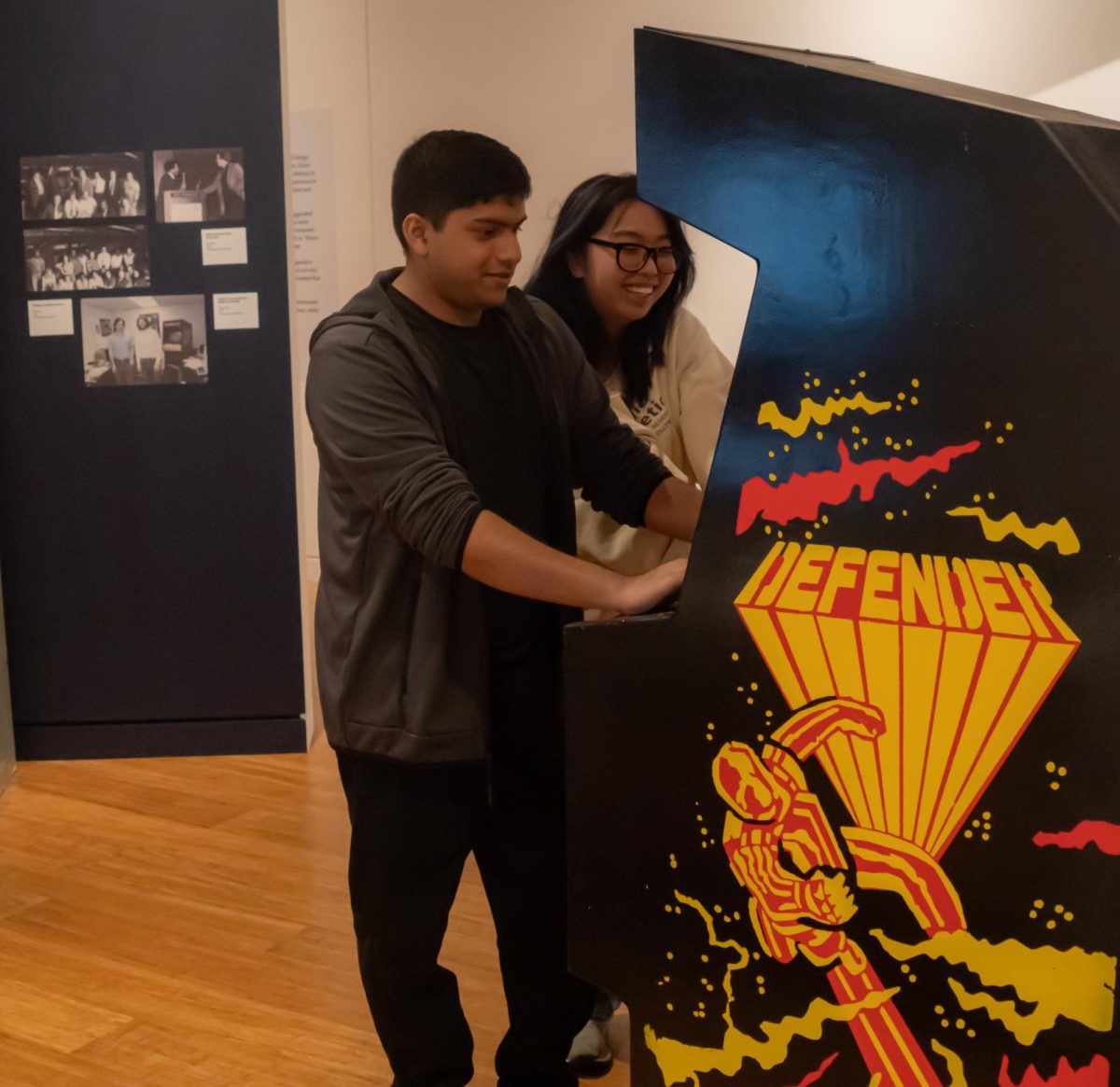During the video game crash of 1983, marked by market saturation and poor-quality products, the arcade was declared dead—until Chicago-based Midway Games came and changed that.
Now, visitors to the Insert Coin exhibit located in the Cleve Carney Museum of Art in the MAC can relive that revival, with 15 playable Midway classics on both arcade cabinets. The exhibit includes retro home consoles like the Nintendo 64, the Playstation 1, and the Super Nintendo Entertainment System.
Walls and display cabinets showcase the distinct artistic processes via concept art and behind-the-scenes photographs that shaped Midway’s games, combining art and technology by using real-life actors and martial artists to craft a more believable and immersive gaming experience. The exhibit aims to encourage visitors to view video games as another form of art through these historical artifacts.
Ryan Ludwig, a Game Design major at College of DuPage, was drawn in by the exhibit’s historical context, especially with the behind-the-scenes content regarding “Mortal Kombat.”
“I was instantly interested in seeing the history and how they got there,” he said. “Looking at the art style from the ‘80s and ‘90s is really interesting. I like the concept art they have on the walls. It’s so cool [to see].”
The content of Midway’s games was heavily inspired by various pop culture phenomena of the time, including comic books and action movies, as well as political and social events such as the 1980s “war on drugs.”
The exhibit takes visitors on a historical tour through the revival of the arcade catalyzed by Midway’s fresh approach to the eventual shift in market preference for home consoles over arcade games. Midway struggled to catch up with this shift, and they later filed for bankruptcy in 2009 after over 50 years of being in the business.
Julia Walker, assistant curator at the Cleve Carney Museum of Art, said despite the difficulties they encountered, the museum strove to obtain all the game artifacts they deemed necessary to effectively tell Midway’s story and convey their impact on the gaming scene.
“The games were chosen based on which ones would best tell the story of the rise and fall of Midway,” she said. “It was difficult to find some of the games, especially Tron, but we ended up being able to include all of the games necessary to convey the narrative. It was also important to make sure that the space was entertaining and interactive while still feeling more like a museum than an arcade.”

The title of the museum sources from a 2020 documentary by the same name directed by filmmaker Joshua Tsui, who was involved in the setup of the Insert Coin exhibit and also serves as the director of innovation at DePaul University.
The museum space contains a variety of interactive games, including Mortal Kombat, NBA Jam, Terminator 2, Cruisin’ USA and many others.
The exhibit also details how Midway’s semi-realistic depiction of violence, particularly in games like “Mortal Kombat,” stirred controversy among parents amid concerns about bad influences on children.
This contributed to court hearings in December 1993 that scrutinized games from various major game developers, including Midway, and eventually led to the formation of the Entertainment Software Rating Board (ESRB).
To this day, the link between aggression and violent video games continues to be a point of debate among scientists and researchers.
Walker noted how Midway perfectly managed the balance between making their games both challenging and fun for consumers.
“Midway was really good at understanding who their consumers were and what they wanted out of a gaming experience,” she said. “They also knew how to make their games challenging and exciting enough that you have to play multiple times (spending more quarters) to master the controls, without being so challenging that they felt the games were impossible to win.”
She said the interactive aspect of the Insert Coin exhibit serves as the foundation of the experience it offers visitors.
“Playing the games brings the information to life because you can actually see what the labels are referring to,” she said. “Not all exhibits need this much interaction to be effective, but this one definitely benefits from the hands-on experience.”
Ludwig’s sentiments aligned with Walker’s regarding the interactive aspect of the exhibit. He recommended that other COD students pay a visit, pointing out that the exhibit is not just fascinating but also fun.
“I think it was a cool choice that they actually ordered a bunch of arcade cabinets in here,” he said. “You’ll get out of it whatever you come in for, [even] if you come in just to have a good time.”
A screening and panel discussion of the eponymous documentary will be hosted at 6 p.m. on Wednesday, Jan. 8, 2025, in the Belushi Auditorium at McAninch Arts Center.
The Insert Coin exhibit will be open to visitors from now until Feb. 16, 2025. Free admission is available to students and staff Tuesday through Thursday from 12 p.m. to 3 p.m. Tickets for the exhibit can be purchased on the Cleve Carney Museum website.









